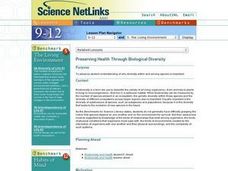Curated OER
Human Evolution
Students investigate hominid evolution to learn the difference between a relative and an ancestor. They study the emergence of bipedalism and the related physical adaptations and cultural ramifications, and chart patterns of hominid...
Curated OER
Introduce Vocabulary: Our Family Tree: An Evolution Story (Peters)
Lisa Peters presents macroevolution as a large-scale family tree in her book Our Family Tree: An Evolution Story. She suggests the process from single-celled organisms to modern-day humans, and learners explore new vocabulary through the...
Curated OER
Compare Human-made Objects with Natural Objects
Students examine and observe how many human-made objects get their basic design from things in nature. They listen to the book "Nature Got There First," compare/contrast hollow bones with drinking straws, bird beaks and tool pliers, and...
Curated OER
Studying Fossils
Students compare and contrast key skeletal differences between chimpanzees and humans: brain size, teeth, hand and thumb, trunk, pelvis, lower limb, foot and big toe. They then sort and group a set of mixed "fossil bones" of chimpanzee...
Curated OER
Primate Evolution
In this primate evolution worksheet, students will review the structures and functions that are characteristic of primates. Students will identify the differences between Old World monkeys, New World monkeys, and prosimians. This...
Curated OER
Comparing Fossils
Students explore early hominid evolution as they analyze bones that share characteristics of both apes and humans. Students compare and contrast key skeletal differences between chimpanzees and humans. In groups, they sort and group a...
Curated OER
Why Kosovo? Why Now?
Middle schoolers explain the establishment of the modern state of Yugoslavia and the breakup of the country. They examine the human characteristics of the region - ethnic groups, languages, and religions.
Curated OER
Preserving Health Through Biological Diversity
Young scholars research and explore the benefits of biodiversity, particularly as it relates to human health. They write an essay in which they explain the possible effect of human activities on the emergence of new diseases.
Curated OER
Carbon Monoxide and Population Density
Tenth graders investigate the carbon monoxide level at a fixed latitude to determine if there is a relationship to population density. They download data sets and generate a graph, and find locations using the Earth's coordinate system....
Curated OER
Why do we need Vitamin C in our diet? Or Why do we carry old inactive genes in our genome?
Students explore and explain how mutations in the DNA sequence of a gene may be silent or result in phenotypic change in an organism and in its offspring. They analyze how evolution and biodiversity are the result of genetic changes that...
Curated OER
Time Is of the Essence
Young scholars study the evolution of the Civil Rights Movement from slavery to the present day. They make a timeline using the major events.
Curated OER
Countdown Calendar
Students create a calendar of endangered species. In this preservation instructional activity, students research endangered species of plants and animals around the Lake Pontchartrain Basin. Students gather facts about the endangered...
Curated OER
Fossils: The Eras of the Earth's History
Students research the four geologic eras of Earth's history. In this extension on a fossils instructional activity, students research the different eras of Earth's history. Students use AppleWorks to create a bar graph containing...
PBS
Pbs Nova: Who's Who in Human Evolution
Easy-to-understand chart of human evolution that traces hominins back more than six million years. Follow along using this clickable illustration right up to us, Homo sapiens. Clicking on each name will provide a brief descriptive...
BiologyWise
Biology Wise: A Comparative Analysis: Homo Habilis vs. Homo Erectus
Describes Homo habilis and Homo erectus, two early ancestors of humans. Discusses how they were discovered, their characteristics, and what we know about them, with the information clearly laid out in a chart along with some comparative...
Other
Washington State University: Hominid Species Timeline
This complete resource contains a chronological chart that shows the main hominid species and their approximate relationships in time. A description of each hominid is included as well.
















